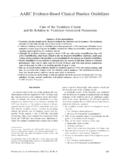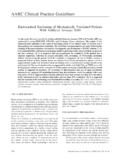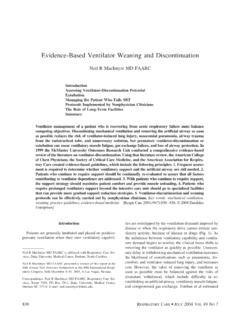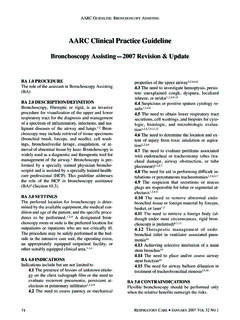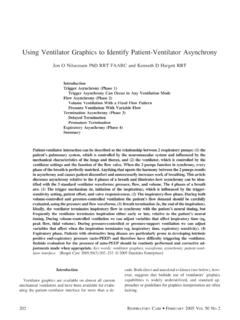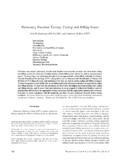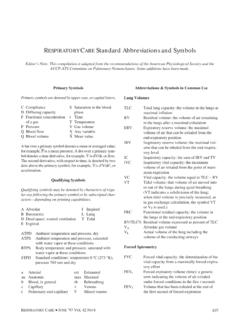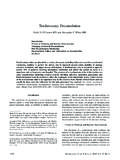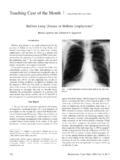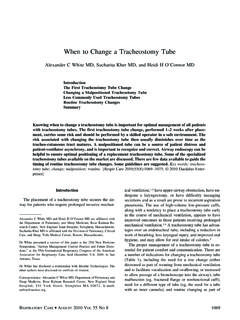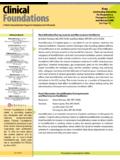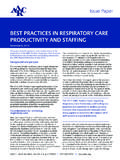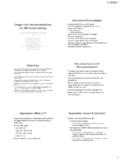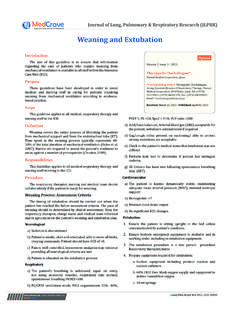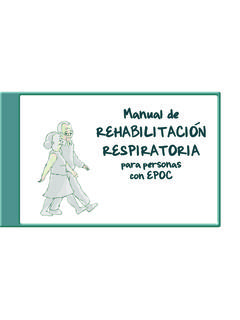Transcription of AARC Clinical Practice Guideline - Respiratory Care
1 AARC Guideline : NASOTRACHEALSUCTIONING1080 RESPIRATORYCARE SEPTEMBER2004 VOL49 NO9 NTS PROCEDURE:Nasotracheal suctioning (NTS) for tracheal aspira-tion is a component of resuscitation and bronchialhygiene DESCRIPTION/DEFINITION:NTS is intended to remove accumulated saliva, pul-monary secretions, blood, vomitus, and other for-eign material from the trachea and nasopharyngealarea that cannot be removed by the patient s sponta-neous cough or other less invasive procedures. NTShas been used to maintain a patent airway thus en-suring adequate oxygenation and ventilation2andavoiding intubation that was solely intended for theremoval of ,3-6 NTS refers to the insertion of a suction catheterthrough the nasal passage and pharynx into the tra-chea without a tracheal tube or tracheostomy (al-though a nasopharyngeal airway may be used)
2 3,7inorder to aspirate accumulated secretions or ,4,6 The clearance of secretions is accomplished by ap-plication of subatmospheric pressure applied to asterile, flexible, multi-eyed catheter1,6,8-10on with-drawal subatmospheric pres-sures Neonates: 60-80 mm Hg16, Infants: 80-100 mm Hg16, Children: 100-120 mm Hg13, Adults: 100-150 mm Hg1,19 Negative pressures should not exceed 150 mm Hgas higher pressures have been shown to cause trau-ma, hypoxemia and ,12,14,20-25 NTS SETTINGS:NTS is performed in a wide variety of settings, andthis Guideline applies to patients of all room or acute care and skilled nursing or ambulatory careNTS INDICATIONS.
3 The need to maintain a patent airway and removesaliva, pulmonary secretions, blood, vomitus, orforeign material from the trachea in the presence to clear secretions when audible orvisible evidence of secretions in the large/cen-tral airways that persist in spite of patient s bestcough ,5,6,25-27 This is evidenced by oneor more of the Visible secretions in the airway1, Chest auscultation of coarse, gur-gling breath sounds, rhonchi1,14,21,27,28ordiminished breath Feeling of secretions in the chest(increased tactile fremitus) Suspected aspiration of gastric orupper airway Clinically apparent increased workof Deterioration of arterial blood gasvalues suggesting hypoxemia or hyper-carbia1, Chest radiographic evidence of re-tained secretions resulting in atelectasis orconsolidation1, , To stimulate cough1,2,27,29or for To obtain a sputum sample for microbiolog-ical or cytological analysis1,2,27 NTS CONTRAINDICATIONS.
4 Listed contraindications are relative unless markedas nasal passages1,6 AARC Clinical Practice GuidelineNasotracheal Suctioning 2004 Revision & UpdateAARC Guideline : NASOTRACHEALSUCTIONING1081 RESPIRATORYCARE SEPTEMBER2004 VOL49 or croup (absolute)1, head, facial, or neck injury1,2, or bleeding disorder1,3, ,3, Respiratory tract Gastric surgery with high Myocardial Bronchospasm2 NTS HAZARDS/ trauma (mucosal hemorrhage,tracheitis, epitaxis from laceration of nasalturbinates, and perforation of the phar-ynx)1,6,14,17,26,27, of nasal turbinates8, of the , hemorrhage2, Uvular ,2,6,17,27,33, dysrhythmias/arrest2,4,6,14, ,2,6,27,38, in blood pressure1,2,6,38,40, , coughing1,2,7, ,6,7, ,3, ,14,33, ,41and pain1,2,7, infection1,2,27,34, ,8,14,17,27, of catheter6,7, intracranial pressure(ICP)6,28,40,41,45, hemorrhage14,40, of cerebral Pneumothorax17 NTS LIMITATIONS OF is a blind procedure with inherent risks(refer to complications).
5 1,6,7, are increased in a combative or unco-operative of application of subatmosphericpressure, or suction, should be limited to nogreater than 15 ,2,6,9,13,14,17,20,21,24,28,39, exists concerning possibleoveruse of this ,14,26,52 NTS ASSESSMENT OF should perform a baseline assess-ment for indications of Respiratory distress andthe need for NTS as recognized by presentingindications as listed above. This should includebut not be limited Auscultation of chest1,3,9,12,14,27,53, Monitor patient s heart rate3,12, rhythm12, Oxygen saturation12, Skin color and should assess effective-ness of Prepare the patient for the procedure by pro-viding an appropriate explanation along withadequate sedation and pain relief as ,9,12 NTS ASSESSMENT OF OUTCOME.
6 Effectiveness of NTS should be reflected by assess-ing patient post suction breath sounds1, of secretions1, Improved blood gas data or pulse Decreased work of breathing (decreasedrespiratory rate or dyspnea)1 NTS source1,6, , adjustable regulator1, vessel and , flexible, multiple-eyed suc-tion catheter1,6,8-10of appropriate cal-iber1,6,10,27,52, disposable gloves1,6,27, water and cup1, lubricant1,6,27,52and/ornormal saline1, anesthetic is sometimes usedto reduce airway when fre-quent NTS is required1,3,7, bag withmask1,6,27,35,56 AARC Guideline .
7 NASOTRACHEALSUCTIONING1082 RESPIRATORYCARE SEPTEMBER2004 VOL49 NO9In the acute care setting, with initiation of NTS orwhen working with the unstable patient, the follow-ing are monitor1, (hyperoxygenation withappropriate delivery device as indicat-ed)1,6,14,27,28,39,41,51,57, protective equipmentfor Standard Precautions1,12,20,23, Level Icaregiver may be theprovider of service afterLevel II personnelhave established need by patient assessmentand the first NTS episode has been complet-ed. Level I personnel must of proper assem-bly and use of of upper airwayanatomy and physiology35, to recognize secretionretention on auscultation1,3,12,27, Ability to monitor vital signsand assess patient s condition and re-sponse to procedure3,12, to recognize and re-spond to adverse reactions and compli-cations of to employ technique ofcardiopulmonary resuscitation to evaluate and docu-ment procedure effectiveness and pa-tient Level IIprovider initially assessesthe patient, determines the need for NTS.
8 And evaluates response to and effectivenessof first episode. Level II personnel have allthe skills of Level I providers and understandingof patient s disease, goals, and limita-tion of and understand-ing of basis of to perform initial treat-ment and be available to troubleshootthe to modify techniquesand equipment and take definitive ac-tion in response to adverse to detect adverse reac-tions and avoid patient harm by em-ploying techniques of cardiopulmonaryresuscitation with mechanical airwayadjuncts and bag-mask of basic electrocar-diogram and dysrhythmia of signs andsymptoms of decreased cardiac output,oxygenation.
9 And to teach Level I andlay personnel providing home care should be provided bylay personnel trained and knowledgeable assembly and use positioning of suctioning Signs and symptoms of respi-ratory of patient re-sponse to to adverse and cleaning of equipmentNTS MONITORING:The following should be monitored before, duringand following the sounds1,3,12,27, color1,6,12, pattern and rate1,6, rate, dysrhythmia, electrocardio-gram if available1,6,12,14,27, , consistency, and volume of secre-tions1, of bleeding or evidence of physi-cal trauma1, response including pain1,2,7,41, (pulse oximeter)1,2,3,6,12, pressure (ICP), if equipmentis Arterial blood pressure if Laryngospasm6 NTS FREQUENCY.
10 Nasotracheal suctioning should be performed by askilled caregiver when indicated and when othermethods to remove secretions from airway ,5,6,8,26,52,54 AARC Guideline : NASOTRACHEALSUCTIONING1083 RESPIRATORYCARE SEPTEMBER2004 VOL49 NO9 NTS INFECTION guidelines for Standard Precautionsshould be adhered ,12,20,23,60, equipment and supplies should be ap-propriately disposed of or ,23,62 Revised by Kim Bennion RRT, Primary Children sMedical Center, Salt Lake City, Utah, and approvedby the 2003 CPG Steering CommitteeOriginal Publication: Respir Care 1992:37(8) Burton GG, Hodgkin JE, Ward JJ, editors.
